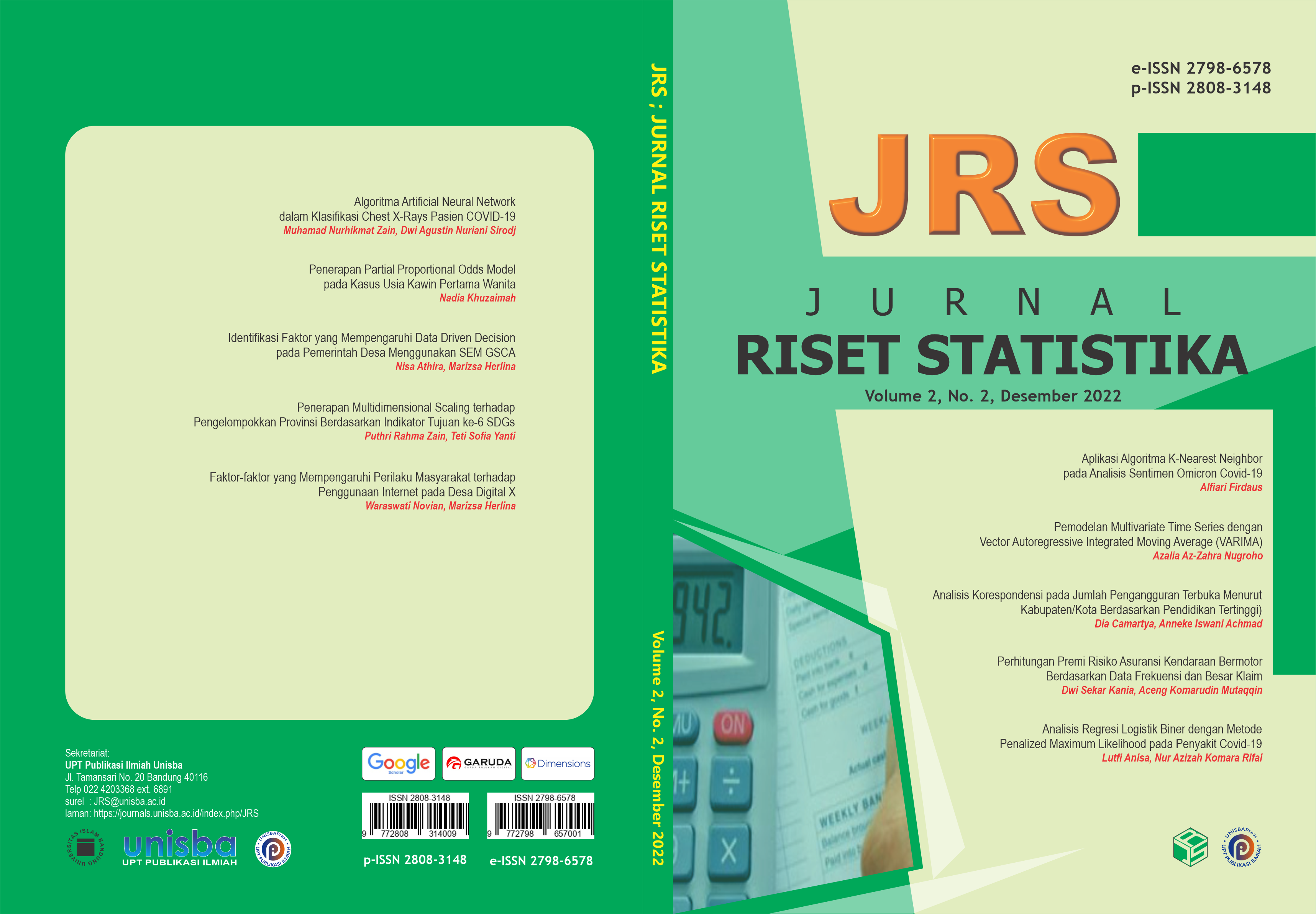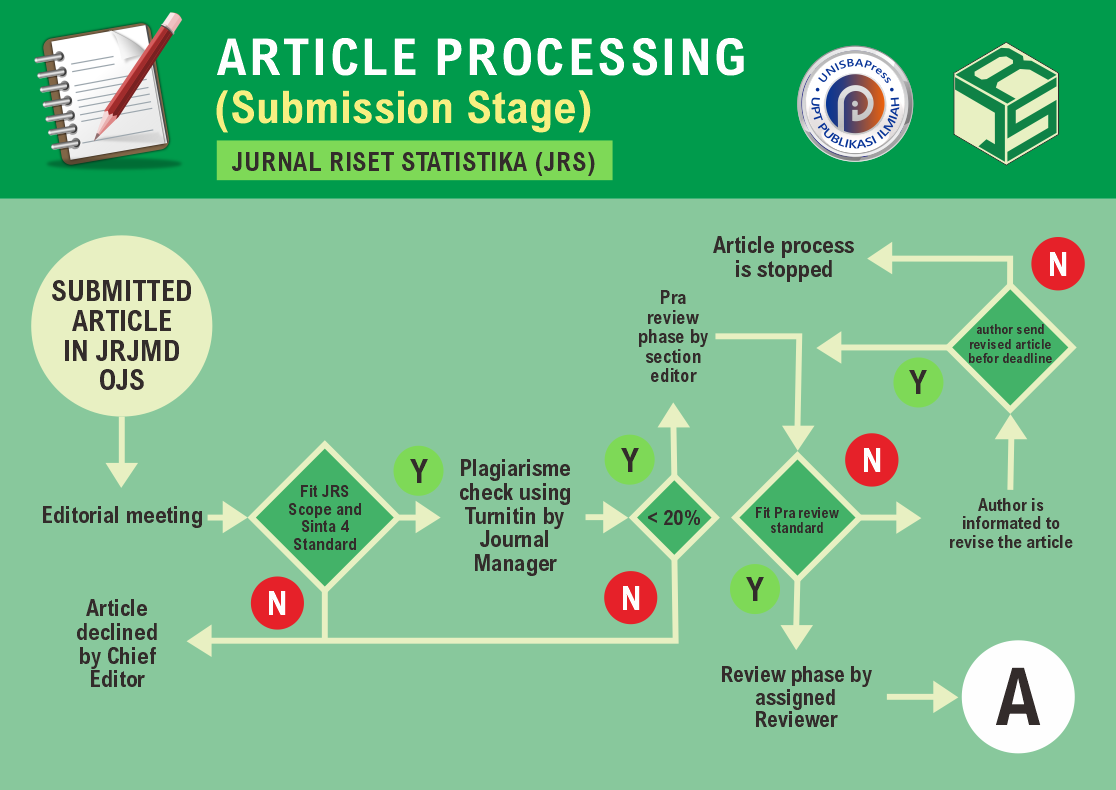Analisis Regresi Logistik Biner dengan Metode Penalized Maximum Likelihood pada Penyakit Covid-19 di RSUD Pringsewu
DOI:
https://doi.org/10.29313/jrs.v2i2.1425Keywords:
Covid-19, Regresi Logistik Biner, Penalized Maximum LikelihoodAbstract
Abstract. Parameter estimation from binary logistic regression models is usually solved using the maximum likelihood estimation (MLE) method which is then completed by the Newton-Raphson iteration method. However, in certain circumstances the MLE method cannot be used if there is one or a combination of several explanatory variables and the response is a separation case problem that causes the estimators to not converge. To overcome this problem, the penalized maximum likelihood estimation (PMLE). The results of the analysis of this study indicate that the Covid-19 patient data at the Pringsewu Hospital contains a quasi-complete separation, so the PMLE method approach is used. The estimation of the best model parameters for this data contains factors of gender, age, congenital disease (comorbid), and symptoms of shortness of breath that significantly affect the mortality rate due to Covid-19. From the results of the analysis of this study when compared with previous studies Sholihin, et al. In the journal entitled " Implementasi Metode Penalized Maximum Likelihood Estimation Pada Model Regresi Logistik Biner " it is proven that binary logistic regression analysis if the data has case separation problems using the PMLE method can give better results.
Abstrak. Estimasi parameter dari model regresi logistik biner biasanya diselesaikan dengan menggunakan metode maximum likelihood estimation (MLE) yang selajutnya diselesaikan metode iterasi Newton-Raphson. Namun, dalam keadaan tertentu metode MLE tidak bisa digunakan jika terdapat satu atau kombinasi beberapa variabel penjelas dan respon terdapat masalah pemisahan pada data (separation case) yang mengakibatkan penduga menjadi tidak konvergen. Untuk mengatasi masalah tersebut, digunakan pendekatan metode penalized maximum likelihood estimation (PMLE). Hasil analisis terhadap penelitian ini menunjukan bahwa data pasien Covid-19 RSUD Pringsewu mengandung pemisahan kurang sempurna (quasi-complete separation), sehingga digunakan pendekatan metode PMLE. Penaksiran parameter model terbaik bagi data ini mengandung faktor jenis kelamin, umur, penyakit bawaan (komorbid), dan gejala sesak nafas yang berpengaruh secara signifikan terhadap tingkat kematian akibat Covid-19. Dari hasil analisis penelitian ini jika dibandingkan dengan penelitian terdahulu Sholihin, et al. Dalam jurnal yang berjudul “Implementasi Metode Penalized Maximum Likelihood Estimation Pada Model Regresi Logistik Biner” terbukti bahwa analisis regresi logistik biner jika datanya terdapat masalah separation case dengan menggunakan metode PMLE dapat memberikan hasil yang lebih baik.
References
D. W. Hosmer Jr., S. Lemeshow, and R. X. Sturdivant, Applied Logistic Regression, Third Edition. John Wiley & Sons, Inc., 2013.
Muhammad Bangkit Riksa Utama and N. Hajarisman, “Metode Pemilihan Variabel pada Model Regresi Poisson Menggunakan Metode Nordberg,” J. Ris. Stat., vol. 1, no. 1, pp. 35–42, Jul. 2021, doi: 10.29313/jrs.v1i1.24.
R. Kurniawan, Analisis Regresi. 2016.
F. A. Novianti and S. W. Purnami, “Analisis Diagnosis Pasien Kanker Payudara Menggunakan Regresi Logistik dan Support Vector Machine (SVM) Berdasarkan Hasil Mamografi,” J. SAINS dan Seni ITS, vol. 1, no. 1, pp. D147–D152, 2012.
L. Mubtadiah, “Estimasi parameter model regresi spasial error dengan metode maximum likelihood estimation,” 2011, [Online]. Available: http://etheses.uin-malang.ac.id/id/eprint/6860
A. A. and A. J.A., “On the Existence of Maximum Likelihood Estimates in Logistic Regression Models,” Biometrika, vol. 71, pp. 1–10, 1984, doi: https://doi.org/10.1093/biomet/71.1.1.
S. Devika, L. Jeyaseelan, and G. Sebastian, “Analysis of sparse data in logistic regression in medical research: A newer approach.,” J. Postgrad. Med., vol. 62, no. 1, pp. 26–31, 2016, doi: 10.4103/0022-3859.173193.
F. D., “Bias Reduction of Maximum Likelihood Estimates,” Biometrics, vol. 80, no. 1, pp. 27–38, 1993.
M. Sholihin et al., “Implementasi Metode Penalized Maximum Likelihood Estimation Pada Model Regresi Logistik Biner 1 Pendahuluan,” no. November, pp. 215–222, 2014.
E. Eyduran, “USAGE OF PENALIZED MAXIMUM LIKELIHOOD ESTIMATION METHOD IN MEDICAL RESEARCH: AN ALTERNATIVE TO MAXIMUM LIKELIHOOD ESTIMATION METHOD,” J. Res. Med. Sci., vol. 13, pp. 325–330, 2008.













